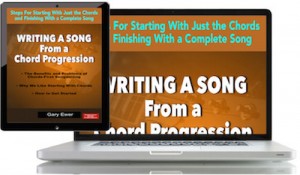Yesterday’s blog was all about using chord inversions — so-called “slash chords” — in your songs. It got me thinking about other aspects of chord use in songs. Here is a quick list of five things every songwriter should know about this very important topic:
1. Chords work very much the same way regardless of your genre of choice.
The basics of chords — how they are formed, how they move from one to another, and so on — have little to do with genre. The differences in the sounds of chords when you compare, let’s say, country music and jazz, comes down to added notes within a chord. In jazz, you’re far more likely to use a G13 than you are in country.
This means that you can look through lists of chord progressions to find one you like, and not concern yourself about what genre those progressions are best suited. You might have to then think about added tones that are appropriate for your genre. But, to put it simply, every genre has a I-IV-V type of progression; it’s just that you may have to consider the chord manipulations that are standard for the genre you’re working in.
 If you like the chords-first songwriting method, you need to be sure you aren’t compromising the quality of your melodies. “Writing a Song From a Chord Progression” shows you the best way to create compelling songs by starting with the chords. This eBook is part of “The Essential Secrets of Songwriting 10-eBook Bundle”
If you like the chords-first songwriting method, you need to be sure you aren’t compromising the quality of your melodies. “Writing a Song From a Chord Progression” shows you the best way to create compelling songs by starting with the chords. This eBook is part of “The Essential Secrets of Songwriting 10-eBook Bundle”
2. There’s no such thing as a chord progression that’s too simple.
You can come up with gorgeous music that is based on nothing more than that standard I-IV-V-I progression. The gorgeousness will come from the melody you create above the chords, the lyrics you add to the melody, and your instrumental choices.
True, there is a greater danger of stagnation within a song that can happen because the musical journey offered by a simple progression is less adventurous than one offered by a more complex one. But in my experience, as long as you’re aware of that danger, there are many non-chord-related solutions to keep your song sounding interesting.
3. Regardless of genre, a good chord progression is all about the journey away from and back to the tonic chord.
There is an inherent danger in improvising chords for your song, which is that you can lose track of where the tonic chord is. If you think of a chord progression as a kind of musical journey, that journey practically always uses the tonic chord as an anchor: progressions will move away from it, and then back toward it.
What happens in the middle often comes down to genre. Pop and country songs usually use shorter progressions, while jazz and more progressive style rock songs will often use longer ones.
But no matter how many chords you toss into the mix, all you really should be doing is making the distance from tonic to tonic longer. In other words, it’s practically always about the tonic chord.
4. Adding tones and otherwise manipulating a simple progression is the first best thing to try if you want more complex progressions.
If you find that your progression doesn’t sound adventurous enough for your tastes, you can throw it out and try to come up with something more complex, but the first thing you should try is to take what you’ve written and make some manipulations.
The kind of manipulations I’m suggesting involve adding tones to certain chords (e.g., C might become Cadd9), using inversions (see yesterday’s blog article), or trying a bass pedal point (see this article: “The Best Way to Use Pedal Point in Your Chord Progressions“)
5. How chords are played is often every bit as important as the chords themselves.
If you think of a song like Eagles’ “Life In the Fast Lane”, you’ll notice that each chord lasts for a long time, at least 2 bars, and sometimes as much as 12. But the instrumental work that goes on while those chords are being played is what keeps us listening.
So one of the best ways to get better mileage from a chord progression is to work on your performance chops. Become a better player, and use better players in your recordings. Good songs are all about giving listeners a great musical experience, and that includes writing great melodies, using great lyrics, and then offering the listeners a top-notch performance.
 Written by Gary Ewer. Follow Gary on Twitter.
Written by Gary Ewer. Follow Gary on Twitter.
 The perfect combination: “The Essential Secrets of Songwriting 10-eBook Bundle” and a Study Guide! Dig into the songwriting manuals that thousands of songwriters are using to polish their technique, complete with a study guide to show you how to progress through the materials.
The perfect combination: “The Essential Secrets of Songwriting 10-eBook Bundle” and a Study Guide! Dig into the songwriting manuals that thousands of songwriters are using to polish their technique, complete with a study guide to show you how to progress through the materials.










